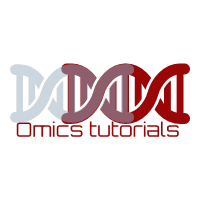
Bioinformatics glossary – M
November 9, 2018A | B | C | D | E | F | G | H | I | J | K | L | M | N | O | P | Q | R | S | T | U | V | W | X | Y | Z
Bioinformatics glossary – M
M
M is the single-letter amino acid code for Methionine.
Macromolecule
General term for protein, nucleic acid or polysaccharide or other very large polymeric organic molecule. alt. macromolecular.
Manual annotation
Annotation involves taking data and presenting it in a way that will allow for the extraction of information by adding further knowledge to the data (meta-data). Manual annotation is undertaken by humans, and although this is more labour intensive than automatic annotation, it is generally considered to be more precise.
In Ensembl database: Manual annotation of the human, mouse and zebrafish genomes from the VEGA/Havana group refers to genes that have been individually analysed by a team of experts in order to determine the transcript set at each locus.
http://www.sanger.ac.uk/resources/databases/vega/
In UniProt database: Manual annotation (or curation) consists of a critical review of experimental and predicted data for each protein as well as manual verification of each protein sequence. Curation methods applied to UniProtKB/Swiss-Prot include manual extraction and structuring of information from the literature, manual verification of results from computational analyses, mining and integration of large-scale data sets, and continuous updating as new information becomes available.
Examples of manually annotated databses include UniProtKB/Swiss-Prot and IntAct.
MACiE
MACiE (Mechanism, Annotation and Classification in Enzymes) is a database of fully annotated enzyme reaction mechanisms. www.ebi.ac.uk/thornton-srv/databases/MACiE/
Map unit
A measure of genetic distance between two linked genes that corresponds to a recombination frequency of 1%.
Markov chain
Any multivariate probability density whose independence diagram is a chain.The variables are ordered, and each variable “depends” only on its neighbors in the sense of being conditionally independent of the others. Markov chains are an integral component of hidden Markov models.
Meiosis
A process within the cell nucleus that results in the reduction of the chromosome number from diploid (two copies of each chromosome) to haploid (a single copy) through two reductive divisions in germ cells.
Medical informatics
The interdisciplinary study of the design, development, adoption and application of IT-based innovations in healthcare services delivery.
Medline
Medline stands for Medical Literature Analysis and Retrieval System Online. It is an international literature database of life sciences and biomedical information. It was established by the U.S. National Library of Medicine (NLM) in the early 1970s, from the computerized system used to produce the Index Medicus. Today it covers the fields of medicine, nursing, pharmacy, dentistry, veterinary medicine, and health care as well as much of the literature in biology and biochemistry, and fields with no direct medical connection, such as molecular evolution. It is freely available on the Internet and searchable via PubMed and NLM’s National Center for Biotechnology Information’s Entrez system. The database contains more than 15 million records from approximately 5,000 selected publications (NLM Systems, Feb 2007) covering biomedicine and health from 1966 to the present.
A multiple sequence alignment program that aligns via fast Fourier transformations.
Meiosis view
Cell division that results in cells that have half of the chromosomes of the original parent cell. Meiosis is the mechanism by which gametes are produced. Compare to: mitosis.
Mendel, Gregor
A monk who lived from 1822-1884 and developed the first understanding of the basics of inheritance in sexually reproducing organisms by conducting crossing experiments on pea plants. He provided a collection of experimental observations that were translated into generally applicable rules describing how some traits are transferred between generations.
Mendelian inheritance
A set of principles of inheritance derived from the work of Gregor Mendel. In short, these principles state that alleles separate into gametes such that each gamete contains only a single copy of a gene (segregation). Furthermore, the alleles of different genes separate into gametes independently and do not sort based on the inheritance of other genes (independent assortment).
Messenger RNA (mRNA) view
An RNA molecule which carries the message that acts as a template for translation into protein.
Metabolism
The complete set of chemical reactions that happen in an organism. Includes the conversion of food into energy, production of components for new cells and maintenance of existing cells.
Metabolite
Any chemical compound involved in or a product of metabolism.
The study of the set of metabolites present within an organism, cell, or tissue.
The migration of cancer cells to colonize tissues and organs other than those in which they originated.
Microarray (DNA) view
A slide or membrane with small bits of DNA of known sequence fixed to it. Allows detection of genetic sequences by complementary binding of unknown DNA samples that are being tested.
Microbe
A microscopic organism; a micro-organism. Includes bacteria, some fungi, protozoa and viruses.
Microorganism
Any of various microscopic organisms, esp. a bacterium or virus
Microtubules
Are fine hollow protein tubes involved in the intracellular transport of materials and movement of organelles. Microtubules also form the mitotic and meiotic spindles.
Mitochondria view
An Organelle found in the cytoplasm of most eukaryotic cells and responsible for generating the energy for the cell.
Mitochondrial DNA (mtDNA)
A circular DNA molecule found inside each eukaryotic mitochondrion. Codes for most of the proteins needed by the mitochondrion.
Mitosis view
Cell division that produces two daughter cells with chromosomes, and therefore DNA that is identical to the parent cell. Mitosis is the mechanism by which somatic cells are produced. Compare: meiosis.
Molecular chaperones
Proteins that assist in the correct folding or transport of other proteins. This helps to make sure proteins and macro molecular structures are assembled properly and in the right place so they are useful to the cell.
Monosomy view
The condition of missing one chromosome of a pair. In humans, this is usually lethal except in Turner’s syndrome where women have one X chromosome instead of the usual two X chromosomes. (Occasionally also used to refer to missing a part of a chromosome.)
Mosaic
An individual or tissue containing at least two cell lines that differ genetically but that have been derived from the same fertilized egg. Compare: chimera
Mouse model
A system that uses mice as the experimental organisms to answer a question about biology. Mice are used because their genomes have been well studied. There are currently many mouse models available for research that mimic human diseases like obesity, cancer and neurological conditions like Huntington’s disease.
Multifactorial
Refers to a biological or physiological observation that is attributable to many factors. For example, some traits are determined by the interplay between genes and environment. Most common traits like skin colour and height are multifactorial. Although your genes give a rough estimate of your height, environment can also impact your height because if you don’t have adequate nutrition during childhood, you will likely not reach your height potential.
A change in the DNA sequence of an organism that can have no effect, or be either beneficial or harmful.
MEME
A program that uses the statistical techniques of expectation maximization and stochastic sampling to find short patterns in a set of related sequences.
MET
MET is the three-letter amino acid code for Methionine.
Methionine
Methionine (M, MET) is a sulfur containing amino acid that contains a weakly polar (almost aliphatic) side chain.
Motifs
Well conserved regions of sequence generally organized around one or two very highly conserved or selectively mutated residues. Motifs are generally indicative of regions that are likely important to maintain the structure or function (or both) of the molecule.
MSA
Abbreviation for Multiple Sequence Alignment. Also refers to the name of a multiple sequence alignment program that makes uses of multidimensional dynamic programming.
An iterative multiple sequence alignment program that uses a word ( k-tuples or k-mers) technique to speed up the initial distance calculation.
Mutation Event
An evolutionary event in which one or more residues of a sequence were converted or replaced with other residues.
Melting (of DNA)
The denaturation of double-stranded DNA into two single strands by the application of heat. (Denaturation breaks the hydrogen bonds holding the double-stranded DNA together).
Messenger RNA (mRNA)
The complementary RNA copy of DNA formed from a single-stranded DNA template during transcription that migrates from the nucleus to the cytoplasm where it is processed into a sequence carrying the information to code for a polypeptide domain.
The addition of -CH3 (methyl) groups to a target site. Typically such addition occurs on to the cytosine bases of DNA. (see maternal imprinting).
Microarray
A 2D array, typically on a glass, filter, or silicon wafer, upon which genes or gene fragments are deposited or synthesized in a predetermined spatial order allowing them to be made available as probes in a high-throughput, parallel manner.
The miniaturization of chemical reactions or pharmacalogical assays into microscopic tubes or vessels in order to greatly increase their throughput, by placing many of them side-by-side in an array.
Mimetics
Compounds that mimic the function of other molecules via their high degree of structural (conformational) similarity, and hence physio-chemical properties.
Missense mutation
A point mutation in which one codon (triplet of bases) is changed into another designating a different amino acid.
Mitosis
The nuclear division that results in the replication of the genetic material and its redistribution into each of the daughter cells during cell division.
Modeling
In bioinformatics, modeling usually refers to molecular modeling, a process whereby the three-dimensional architecture of biological molecules is interpreted (or predicted), visually represented, and manipulated in order to determine their molecular properties. (general) A series of mathematical equations or procedures which simulate a real-life process, given a set of assumptions, boundary parameters, and initial conditions.
Monomer
A single unit of any biological molecule or macromolecule, such as an amino acid, nucleic acid, polypeptide domain, or protein.
Monovalent
Having one binding site; strictly, an atom with only one free electron available for binding in its highest energy shell.
Motif
A conserved element of a protein sequence alignment that usually correlates with a particular function. Motifs are generated from a local multiple protein sequence alignment corresponding to a region whose function or structure is known. It is sufficient that it is conserved, and is hence likely to be predictive of any subsequent occurrence of such a structural/functional region in any other novel protein sequence.
Multigene family
A set of genes derived by duplication of an ancestral gene, followed by independent mutational events resulting in a series of independent genes either clustered together on a chromosome or dispersed throughout the genome.
Multiple (sequence) alignment
A Multiple Alignment of k sequences is a rectangular array, consisting of characters taken from the alphabet A , that satisfies the following conditions: There are exactly k rows; ignoring the gap character, row number i is exactly the sequence s I ; and each column contains at least one character different from “-“. In practice multiple sequence alignments include a cost/weight function, that defines the penalty for the insertion of gaps (the “-” character) and weights identities and conservative substitutions accordingly. Multiple alignment algorithms attempt to create the optimal alignment defined as the one with the lowest cost/weight score.
Multiplex sequencing
Approach to high-throughput sequencing that uses several pooled DNA samples run through gels simultaneously and then separated and analyzed.
Mutagen
Any agent that can cause an increase in the rate of mutations in an organism.

















